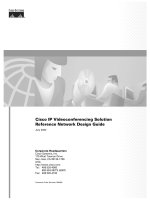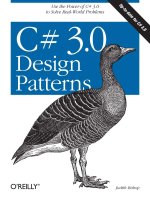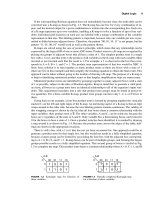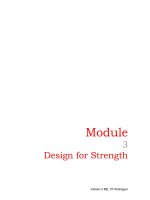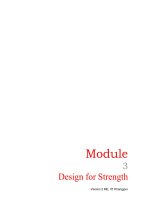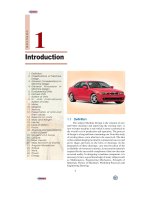MAP DESIGN: GRAPHIC DESIGN BASICS docx
Bạn đang xem bản rút gọn của tài liệu. Xem và tải ngay bản đầy đủ của tài liệu tại đây (4.58 MB, 74 trang )
Map Design: Graphic Design Basics
5.9
1
© copyright:
Kommission Aus- und Weiterbildung,
Deutsche Gesellschaft für Kartographie
e.V., Germany 2000
c/o Reinhard Urbanke
Erlenweg 3/1
D-71394 Kernen im Remstal
EMail:
Start
Map Design:
Graphic Design Basics
Map Design: Graphic Design Basics
5.9
2
Contents
Exercises
Index
Search
Next results
Previous results
Print
Exit
Home
© copyright:
Kommission Aus- und Weiterbildung,
Deutsche Gesellschaft für Kartographie
e.V., Germany 2000
c/o Reinhard Urbanke
Erlenweg 3/1
D-71394 Kernen im Remstal
EMail:
Contents
Map design: Graphic design basics 6
1 Perception 6
Outer and Inner Worlds 6
Perception overload 6
Selection 7
Processing 7
2 Communication 7
Communication 8
Code 9
Languages 10
Communication goals 11
3 Design 12
The form 12
Basic forms 13
Graphic elements 14
Variations 15
Design principles 15
4 Optical Illusions 17
Lines 17
Areas 18
Tonal value 20
5 The area 21
Empty space / white space 21
Map Design: Graphic Design Basics
5.9
3
Contents
Exercises
Index
Search
Next results
Previous results
Exit
Home
© copyright:
Kommission Aus- und Weiterbildung,
Deutsche Gesellschaft für Kartographie
e.V., Germany 2000
c/o Reinhard Urbanke
Erlenweg 3/1
D-71394 Kernen im Remstal
EMail:
Locations of effect 22
Effect 22
Associative meanings 24
6 Area aesthetics 25
Size 25
Area subdivision 26
Composition 27
7 Colour 29
Colour psychology 29
Colour dimension (CIELAB-colour system) 30
Colour contrast 31
8 Type aesthetics 33
Evolution of type 33
Geometry 35
Letter spacing 35
9 Type composition 37
Grey value 37
Reading process 37
Type face selection 38
Type face mixture 39
Compositions 39
Typographic errors 40
10 Signs 41
Communication 41
Function 43
Trademarks 43
Map Design: Graphic Design Basics
5.9
4
Contents
Exercises
Index
Search
Next results
Previous results
Exit
Home
© copyright:
Kommission Aus- und Weiterbildung,
Deutsche Gesellschaft für Kartographie
e.V., Germany 2000
c/o Reinhard Urbanke
Erlenweg 3/1
D-71394 Kernen im Remstal
EMail:
Design 43
To find a shape 44
11 Publications 45
Notepaper and visiting cards 45
Books 46
Dustjacket 47
Magazine 47
Poster 48
Packaging 48
12 Map symbols 49
Symbol system 49
Symbol types 49
Variations 50
Design 51
Map symbols 52
Type 53
13 Map design: Graphic structure 54
Image of nature 54
Purpose of the map 55
55
Legibility 56
Assessment principles 57
14 External map design 58
Principles 58
Map title 59
Scale and linear scale 60
Legend 61
Title page 62
Map Design: Graphic Design Basics
5.9
5
Contents
Exercises
Index
Search
Next results
Previous results
Exit
Home
© copyright:
Kommission Aus- und Weiterbildung,
Deutsche Gesellschaft für Kartographie
e.V., Germany 2000
c/o Reinhard Urbanke
Erlenweg 3/1
D-71394 Kernen im Remstal
EMail:
15 Exercises 62
Perception 62
Communication 63
Area effect 63
Area composition 64
Type balance 65
Typography 65
Logo 66
Notepaper 67
Poster 68
Symbols 68
Map 69
Travel guide 70
Index 72
Map Design: Graphic Design Basics
5.9
6
Contents
Exercises
Index
Search
Next results
Previous results
Exit
Home
© copyright:
Kommission Aus- und Weiterbildung,
Deutsche Gesellschaft für Kartographie
e.V., Germany 2000
c/o Reinhard Urbanke
Erlenweg 3/1
D-71394 Kernen im Remstal
EMail:
Map design: Graphic design basics
1 Perception
Cartographers and design both use visual inter-
human communication. In order to discuss
graphic design, we have to deal with the topic of
the communicating human. But to understand
the communication process, first of all we have
to speak about human perception.
Outer and Inner Worlds
What and how do people perceive?
Well, primarily people perceive their environ-
ment - the outer world. They see, hear, touch,
smell and taste it. For that purpose they have
perceptual organs. During the perception proc-
ess all senses work simultaneously and therefore
it is not easy to decide which sense is decisive
for the occurrence of a reaction in a certain situ-
ation.
Take supper for example: Is the tasting sense
dominating, because the meal is tasting deli-
ciously, or the eye, because the table is nicely
laid out, or the ear, because the conversation
and the music are pleasing? Humans also per-
manently experience themselves, their inner
world. The limbs and organs call our attention if
they are exhausted or diseased. The soul, the
psyche plays an important role deciding on the
state of well-being. Humans feel, they perceive
moods and instincts and know whether they are
walking or sitting or doing something.
Perception overload
People’s inner and outer worlds impact upon
them simultaneously and are perceived in con-
junction. the perception process is a permanent
state during every situation of life, impossible to
switch off. It is impossible also for people to fil-
ter out a specific perception, as in addition to
that they have to survey its environment; like-
wise they cannot switch off one particular sense.
They can only try to concentrate on some specif-
ic aspect.
Map Design: Graphic Design Basics
5.9
7
Contents
Exercises
Index
Search
Next results
Previous results
Exit
Home
© copyright:
Kommission Aus- und Weiterbildung,
Deutsche Gesellschaft für Kartographie
e.V., Germany 2000
c/o Reinhard Urbanke
Erlenweg 3/1
D-71394 Kernen im Remstal
EMail:
Selection
The biggest part of all incoming stimuli is per-
ceived subconsciously and this part decisively
shapes us. To shield from a stimuli overflow peo-
ple can try to perceive part of all information
consciously, just big enough to be digested sep-
arately (selection). The perception process pro-
ceeds as follows:
■ First of all people are confronted with a disor-
dered general impression.
■ Consecutively they select specific information
(selection).
■ They try to order them by looking at them con-
sciously (synthesis).
■ But simultaneously they discover new stimuli and
try to integrate them in their system as well.
■ Finally they receive an ordered whole, an over-
view. While analysing it a feedback process is
initiated influenced by many components.
Processing
The designer intends to effectuate a certain re-
action in the viewer (or customer).
What are the components of human perception
that he has to deal with?
■ The feeling is a spontaneous all-embracing per-
sonal reaction to a perception, responsible for
actions.
■ Needs are caused by a shortage and have to be
satisfied immediately.
■ Interest is controlled by the mind and aims on a
field that is not covered by needs.
■ Motivation is the conscious and subconscious
combination of these components.
■ Expectation is the more or less clear temporary
objective we have in mind.
■ Memory is a conscious or subconscious feedback
factor.
2 Communication
The designer has to deal with the exchange of
information, the communication. He must under-
stand their functioning, the codes and languag-
es. Only then will he be able to define the design
goals.
Map Design: Graphic Design Basics
5.9
8
Contents
Exercises
Index
Search
Next results
Previous results
Exit
Home
© copyright:
Kommission Aus- und Weiterbildung,
Deutsche Gesellschaft für Kartographie
e.V., Germany 2000
c/o Reinhard Urbanke
Erlenweg 3/1
D-71394 Kernen im Remstal
EMail:
Communication
A simplified scheme of (visual) communication
looks a follows:
The transmitter (the designer) communicates
with the receiver (the viewer) by sending mes-
sages with the help of a language (here: pictori-
al language and written language). For that end
he uses codes to transmit his message effective-
ly. A picture, for instance, showing the sea, the
sun and palm trees, is not only an image of the
coast, but leads the viewer to further associa-
tions and can stand for recovery, relaxation,
warmth, holidays etc.
The cartographer uses codes with his symbols as
well.
The symbol
✉ not only stands for a letter, but
also for a post office.
The symbol
does not only mean several
trees and rain forest, but also tropics, humid-
torrid climate, a certain flora and fauna etc.
2a A traffic sign whose meaning is known in Germa-
ny immediately is used in the USA with two explan-
atory texts.
2b The ships do not understand each other because
they use different languages. Although the viewer
cannot understand the dialogue he would be able to
understand the course of events.
Map Design: Graphic Design Basics
5.9
9
Contents
Exercises
Index
Search
Next results
Previous results
Exit
Home
© copyright:
Kommission Aus- und Weiterbildung,
Deutsche Gesellschaft für Kartographie
e.V., Germany 2000
c/o Reinhard Urbanke
Erlenweg 3/1
D-71394 Kernen im Remstal
EMail:
Code
The code encodes messages. The receiver is able
to understand the content only with knowledge
about the code (Example: map legend).
Every symbol has a certain meaning the receiver
has to know.
The spoken language is a code as well: Someone
may for instance understand German fairly well,
French less well and Finnish not at all.
It may happen of course that two or more mean-
ings exist for one symbol .
In maps, for example, the symbol + can stand
for a church, a chapel, a graveyard or a rock.
Shaking our head is also codified: it means No to
us, in Greece it means Yes.
2c Different stars; each of them has its own mean-
ing that exceeds its pure geometric form.
2d: Someone can only use the pattern sheet if he
knows its function and its signs.
Map Design: Graphic Design Basics
5.9
10
Contents
Exercises
Index
Search
Next results
Previous results
Exit
Home
© copyright:
Kommission Aus- und Weiterbildung,
Deutsche Gesellschaft für Kartographie
e.V., Germany 2000
c/o Reinhard Urbanke
Erlenweg 3/1
D-71394 Kernen im Remstal
EMail:
Languages
At the beginning of human history people under-
stood each other through facial expressions and
gestures or sounds.
Information as discoveries, moods, desires or
orders could be thus communicated.
Since the stone age linguistic signs are recorded
permanently by engraving them in wood or
painting them on stone walls. The signs were
taken from nature.
In the 5th century BC schematic pictorial signs
have been stringed together for the first time,
enabling us to visualize trains of thought and
courses of events.
Now languages could be developed according to
cultural expression and social requirements.
Sign-like pictures were combined to form sign
language (e.g. the symbols on maps).
2f: Encoded: sign
language, musical
notation, braille,
machine language,
bar code .
2e: Pictorial lan-
guage: This picture
comprises more than
two windows, one
door, two walls, the
floor and a roof slope.
It transmits a certain
mood.
2g: A possible com-
munication goal: At-
tract attention.
Look here!
Map Design: Graphic Design Basics
5.9
11
Contents
Exercises
Index
Search
Next results
Previous results
Exit
Home
© copyright:
Kommission Aus- und Weiterbildung,
Deutsche Gesellschaft für Kartographie
e.V., Germany 2000
c/o Reinhard Urbanke
Erlenweg 3/1
D-71394 Kernen im Remstal
EMail:
Letters, that are symbols as well, were combined
to form words and finally sentences: the written
language.
Pictures such as photographs, illustrations and
paintings have a pictorial language.
Beyond that further languages exist as sign lan-
guage, braille, musical notation, etc
Communication goals
The designer has to know exactly whom he
wants to address and what he wants to impart.
He has to respond to the receiver, his perception
and his surrounding. He has to comb his design
possibilities for suitable tools. He must use ade-
quate methods, languages and codes.
A designer must be endowed with the following
personal conditions:
■ Sensibility and receptiveness,
■ agility and creativity,
■ ability for abstraction and analysis,
■ ability for synthesis and
■ ability to aesthetical organization.
Map Design: Graphic Design Basics
5.9
12
Contents
Exercises
Index
Search
Next results
Previous results
Exit
Home
© copyright:
Kommission Aus- und Weiterbildung,
Deutsche Gesellschaft für Kartographie
e.V., Germany 2000
c/o Reinhard Urbanke
Erlenweg 3/1
D-71394 Kernen im Remstal
EMail:
3 Design
After this quite abstract introduction the terms
'form' and 'design' will be used to conduct us to
more practical topics.
The form
The form is the composition, the result of the
design process.
In this connection form (the whole thing) means
more than the sum of the parts (Fig. 3a; c. Fig.
2e and the rain forest symbol from the previous
chapter).
The form is even maintained if single elements
are changed.
A form cannot exist without its surroundings.
A form has something like a soul that has to be
filled with life by the designer.
Retiro
Tirso de Molina
Ant n Mart n
Atocha Renfe
Men ndez
Pelayo
Atocha
Ibiza
Conde
del Casal
Rep blica
Argentina
Cruz del
Rayo
er slowenische
Philosoph Slavoj
Zizek ist mit sei-
nen philosophischen Mix-
turen aus Hegels Logik,
Hitchcocks Leichen und
Lacans Leerstellen ein
bekanntes enfant terrible
in akademischen Philoso-
phenzirkeln. Seine Auf-
tritte sind überwältigende
Rede-Performances mit
ungewissem Ausgang.
3a
Map Design: Graphic Design Basics
5.9
13
Contents
Exercises
Index
Search
Next results
Previous results
Exit
Home
© copyright:
Kommission Aus- und Weiterbildung,
Deutsche Gesellschaft für Kartographie
e.V., Germany 2000
c/o Reinhard Urbanke
Erlenweg 3/1
D-71394 Kernen im Remstal
EMail:
1 2 3 4
5
6
7
8
9
10
11
12
13
er slowenische
Philosoph Sla-
voj Zizek ist mit seinen
philosophischen Mixtu-
ren aus Hegels Logik,
Hitchcocks Leichen und
Lacans Leerstellen ein
bekanntes enfant terrible
in akademischen Philoso-
phenzirkeln. Seine Auftrit-
te sind überwältigende
Rede-Performances mit
ungewissem Ausgang.
3b
Basic forms
For the design one tends to fall back gladly on
the elementary basic forms (Fig. 3b, upper row):
Point(1): In the true sense it is a zero-dimen-
sional object and therefore cannot be represent-
ed. In graphic arts a point is that what is not yet
a circle.
Line(2): A one-dimensional object, a stroke.
Area(3): A two-dimensional object, e.g. a rec-
tangle, a circle, a polygon. The area has a form.
Volume/Body(4): A three-dimensional object
that will not be dealt with at this point.
The Slovenian philosopher Sla-
voi Zizek with his philosophic
mixtures of Hegel’s logic,
Hitchcock’s dead bodies and
Lacan’s empty spaces is a
known enfant terrible in aca-
demic philosopher circles. His
entrances are overwhelming
speech-performances with an
unknown end.
Map Design: Graphic Design Basics
5.9
14
Contents
Exercises
Index
Search
Next results
Previous results
Exit
Home
© copyright:
Kommission Aus- und Weiterbildung,
Deutsche Gesellschaft für Kartographie
e.V., Germany 2000
c/o Reinhard Urbanke
Erlenweg 3/1
D-71394 Kernen im Remstal
EMail:
1 2 3 4
5
6
7
8
9
10
11
12
13
er slowenische
Philosoph Sla-
voj Zizek ist mit seinen
philosophischen Mixtu-
ren aus Hegels Logik,
Hitchcocks Leichen und
Lacans Leerstellen ein
bekanntes enfant terrible
in akademischen Philoso-
phenzirkeln. Seine Auftrit-
te sind überwältigende
Rede-Performances mit
ungewissem Ausgang.
3b
Graphic elements
The elements can be simple, composite or com-
plex (Fig. 3b, lower part):
Sign(7, 10): A letter, a logo etc.
Writing(6, 8): Text in books, newspapers, on
posters, in advertisements etc.
Graphic (11, 12): A diagram, a map, an illustra-
tion etc.
Picture (13): A photograph or a detail.
Background (9): The background, the surround-
ing, has to be included in the design even if it is
merely white.
The Slovenian philosopher Sla-
voi Zizek with his philosophic
mixtures of Hegel’s logic,
Hitchcock’s dead bodies and
Lacan’s empty spaces is a
known enfant terrible in aca-
demic philosopher circles. His
entrances are overwhelming
speech-performances with an
unknown end.
Map Design: Graphic Design Basics
5.9
15
Contents
Exercises
Index
Search
Next results
Previous results
Exit
Home
© copyright:
Kommission Aus- und Weiterbildung,
Deutsche Gesellschaft für Kartographie
e.V., Germany 2000
c/o Reinhard Urbanke
Erlenweg 3/1
D-71394 Kernen im Remstal
EMail:
Variations
The forms and elements can be varied by (Fig.
3c):
Structure: The inner arrangement of areal ob-
jects, as screens, hatches, patterns.
Tonal value: The brightness of objects.
Colour: Reaches the viewer directly, puts him in
a certain mood, rouses feelings.
Size: To emphasize, to cause tension.
Position: The position of an object within a com-
position is of substantial importance concerning
its effect.
Design principles
It does not make sense to define rigid design
rules because, as described above, graphic de-
sign is influenced by changing perceptions,
3c
Map Design: Graphic Design Basics
5.9
16
Contents
Exercises
Index
Search
Next results
Previous results
Exit
Home
© copyright:
Kommission Aus- und Weiterbildung,
Deutsche Gesellschaft für Kartographie
e.V., Germany 2000
c/o Reinhard Urbanke
Erlenweg 3/1
D-71394 Kernen im Remstal
EMail:
changing communication methods and changing
design goals.
But the following principles (Fig. 3d) that guar-
antee a good and successful design should still
be considered:
Proportion or the relation between single ob-
jects and their surroundings. Many attempts
have been made to determine the ideal absolute
proportion, but without success. Some models
such as the golden section are considered as be-
ing almost perfect.
Harmony: A design is harmonic when it is well
ordered and when all internal elements have
been combined properly according to an aes-
thetic sense, which means that nothing disturbs,
tips over or drops out.
Contrast: Every effect is based on contrast.
Contrast creates tension and therewith the at-
tention of the viewer. It is created through the
use of contrast pairs: To be activated every ob-
ject needs a counter object.
By the detailed inspection of countless design
examples a designer should try to get a reliable
flair for proportions, harmony and good design.
3d
Map Design: Graphic Design Basics
5.9
17
Contents
Exercises
Index
Search
Next results
Previous results
Exit
Home
© copyright:
Kommission Aus- und Weiterbildung,
Deutsche Gesellschaft für Kartographie
e.V., Germany 2000
c/o Reinhard Urbanke
Erlenweg 3/1
D-71394 Kernen im Remstal
EMail:
4a
4b
4c
4 Optical Illusions
Optical illusions are of particular interest due to
their unexpected results and the effects thus
achieved. They show again that the personal
aesthetic experience is set above the strict geo-
metric construction.
Lines
Fig. 4a demonstrates that vertical lines of the
same length seem to differ in length if their add-
ed corners are changed. As a result sharp and
round letters must jut out from the type line
(Schriftlinie) so that they do not seem smaller
than the letters D and T.
Fig. 4b shows that repeatedly subdivided lines
seem longer that undivided.
In Fig. 4c thick narrow set lines appear shorter
than the ones that are further apart. For that
reason type faces with thin line gauges seem to
be higher than that with bold ones.
Map Design: Graphic Design Basics
5.9
18
Contents
Exercises
Index
Search
Next results
Previous results
Exit
Home
© copyright:
Kommission Aus- und Weiterbildung,
Deutsche Gesellschaft für Kartographie
e.V., Germany 2000
c/o Reinhard Urbanke
Erlenweg 3/1
D-71394 Kernen im Remstal
EMail:
4f
4g
4d
4e
The optic centre is not always the same as the
geometric center, as shown by Fig. 4d.
The Futur type face has been constructed geo-
metrically but was subsequently modified ac-
cording to optic-aesthetic viewpoints. Because
of that it appears calmer and more harmonic
now.
Fig. 4e shows optical deformations: The circle
seems dented and the single line repeatedly bro-
ken.
Areas
A square optically seems wider than higher.
Therefore squares must be exaggerated vertical-
ly (Fig. 4f). The same applies to circles.
Map Design: Graphic Design Basics
5.9
19
Contents
Exercises
Index
Search
Next results
Previous results
Exit
Home
© copyright:
Kommission Aus- und Weiterbildung,
Deutsche Gesellschaft für Kartographie
e.V., Germany 2000
c/o Reinhard Urbanke
Erlenweg 3/1
D-71394 Kernen im Remstal
EMail:
AB AB
4h
4j
4i
In Fig. 4g the horizontal lines
widen the square area whereas
the vertical ones exaggerate it
vertically.
In Fig. 4h all central squares
have the same size. Their apparent size (the
other squares and the white space) is influenced
by their surrounding.
In Fig. 4i and 4j the bright areas (or letters)
seem larger than the dark areas (or letters) of
Map Design: Graphic Design Basics
5.9
20
Contents
Exercises
Index
Search
Next results
Previous results
Exit
Home
© copyright:
Kommission Aus- und Weiterbildung,
Deutsche Gesellschaft für Kartographie
e.V., Germany 2000
c/o Reinhard Urbanke
Erlenweg 3/1
D-71394 Kernen im Remstal
EMail:
4k
the same size because their brightness out-
shines their contour.
Tonal value
In Fig. 4k it becomes apparent of how little im-
portance the actual brightness is (all inner
squares have the same grey value). Their sur-
rounding is decisive for the effect of the grey ar-
eas.
It is possible to create depth with the help of
tonal values: the inner square in the left field
seems to lie clearly above the surface area
whereas in the most right one the black area
seems to be a window.
Map Design: Graphic Design Basics
5.9
21
Contents
Exercises
Index
Search
Next results
Previous results
Exit
Home
© copyright:
Kommission Aus- und Weiterbildung,
Deutsche Gesellschaft für Kartographie
e.V., Germany 2000
c/o Reinhard Urbanke
Erlenweg 3/1
D-71394 Kernen im Remstal
EMail:
5a
5b
5c
5 The area
The area is the space for mounting the design. It
should be sufficiently considered because the
area more or less influences the elements ar-
ranged on it.
Empty space / white space
Some elements need a big area (empty space)
to unfold. Empty spaces are fields of force.
A composition can appear disharmonious if the
empty space is not incorporated. A design can
be thrown out of balance or upset optically if the
relation between printed and empty areas is dis-
turbed. Empty space can create tension and dy-
namics in connection with design elements. It
can order and emphasize them.
Even a completely empty area is not empty for
the viewer: he wanders around with his eyes
(Fig. 5b, a typical reading loop), projects things
on it and divides it into specific sub-areas (Fig.
5c).
Map Design: Graphic Design Basics
5.9
22
Contents
Exercises
Index
Search
Next results
Previous results
Exit
Home
© copyright:
Kommission Aus- und Weiterbildung,
Deutsche Gesellschaft für Kartographie
e.V., Germany 2000
c/o Reinhard Urbanke
Erlenweg 3/1
D-71394 Kernen im Remstal
EMail:
5d
5e
Locations of effect
If an area is divided in the middle, the upper half
seems to be larger than the lower half (Fig. 5d).
Elements positioned in the upper sector seem
more weighty than the ones below.
This has to do with the natural human field of vi-
sion. Above the horizon people expect just the
sky which seems to be unlimited. This viewing
habit is unconsciously applied to the area.
In the same way the left and the right side of the
area have different meanings. The reading direc-
tion proceeds from left to right. People feel a
movement mostly directed to the right. There-
fore the right side is more important than the
left one (Fig. 5e).
Effect
As a consequence elements get a certain mean-
ing if they are located at a certain spot within
Map Design: Graphic Design Basics
5.9
23
Contents
Exercises
Index
Search
Next results
Previous results
Exit
Home
© copyright:
Kommission Aus- und Weiterbildung,
Deutsche Gesellschaft für Kartographie
e.V., Germany 2000
c/o Reinhard Urbanke
Erlenweg 3/1
D-71394 Kernen im Remstal
EMail:
quiet, at the
objective
calmness passive, nearactive, far
restless, move-
ment to the right
5f
negative
5h
passive,
left right
active,
bottom top
seemingly
endless
positive
5g
the empty space. Points appear calm and stable
if they lie on lines in Fig, 5c, but restless and dy-
namic off them (Fig. 5f).
Lines have different qualities as well, depending
on their location (Fig. 5g and h).
The effect can be described by adjectives as
light, heavy, floating, unstable, rising, distant
etc.
Fig. 5i shows different black elements on white
areas with a specific effect in each case.
Map Design: Graphic Design Basics
5.9
24
Contents
Exercises
Index
Search
Next results
Previous results
Exit
Home
© copyright:
Kommission Aus- und Weiterbildung,
Deutsche Gesellschaft für Kartographie
e.V., Germany 2000
c/o Reinhard Urbanke
Erlenweg 3/1
D-71394 Kernen im Remstal
EMail:
5i
THE HORIZONTAL:
horizon
sea
steppe
plain
calmness
sleep
death
impressive
important
quiet
LEFT:
passiveness
reflection
introversion
past
self
CLIMBING THE
VERTICAL:
tower
obelisk
fountain
powerful
RIGHT:
activity
deed
extroversion
future
you
DESCENDING THE
VERTICAL:
plumb line
weight
heavy
serious
Associative meanings
Empirical investigations have resulted in discerning specific associative meanings:
Now, if one tries to look at the white spaces as
new forms in their own right, that lie before a
grey background, a new effect can be realized.
The general effect is changed by every new ele-
ment within the design.
Map Design: Graphic Design Basics
5.9
25
Contents
Exercises
Index
Search
Next results
Previous results
Exit
Home
© copyright:
Kommission Aus- und Weiterbildung,
Deutsche Gesellschaft für Kartographie
e.V., Germany 2000
c/o Reinhard Urbanke
Erlenweg 3/1
D-71394 Kernen im Remstal
EMail:
2 : 3 1 : 1,538
(base line
and height of
a pentagon)
5 : 8
(approxima
golden section)
(DIN A-size)
6a
2:1
3:1
5:1
6 Area aesthetics
We have already spoken about the importance of
the area as the mounting space. Now, the pro-
portions, distribution and composition will be
analysed.
Size
Already at the beginning of the design process
the designer has to decide about a page size.
The size and shape naturally depends on the
purpose: Is the design object a map, a folder or
a book?
There are shapes whose proportions seem to be
especially well balanced, including the golden
section.
Squares can look interesting as well if they are
divided appropriately.



